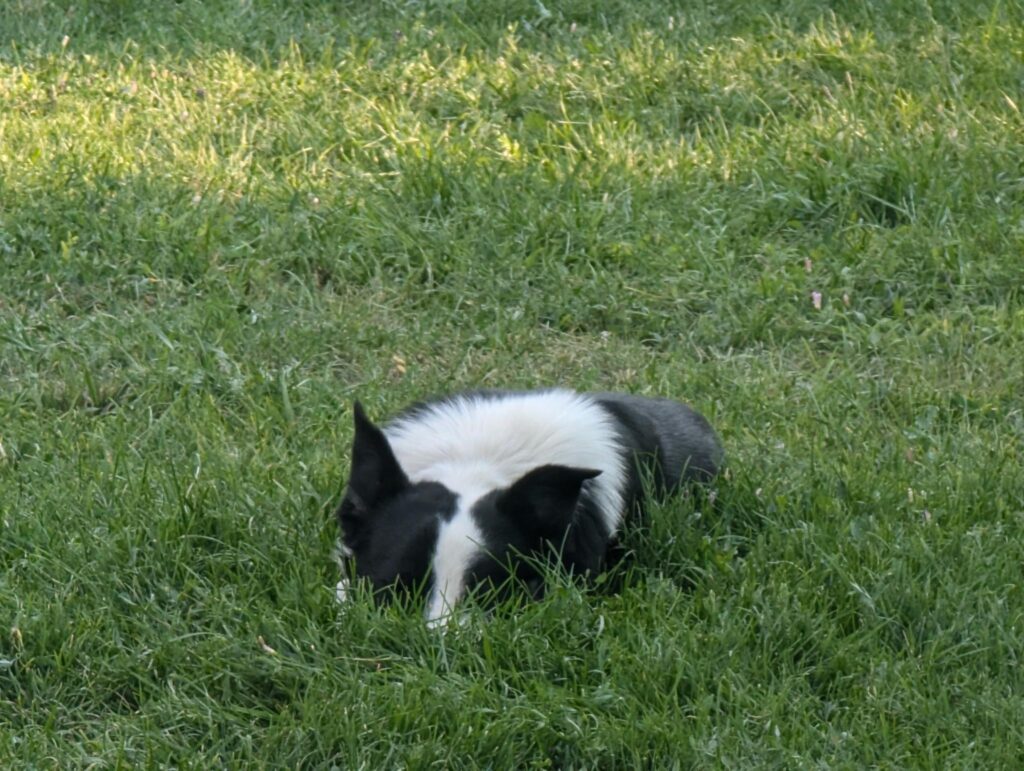W1D5, Introducing “Heel” and “Sit” with the Wonder Lead

Monkey nailed the D4 Square Longe so today I’m moving him on to a semicircular, Yin-Yang pattern. After applying a fresh coat of barrier scent to the garden hose which marks the boundary of my ring, the distinction between inside and outside the working area should be very apparent, but I still start my session out with a lap around the outside of the ring so that Monkey can reorient himself with the border. Today, we will travel across the center of the ring from 6:00 to 12:00, passing by Ellie, alternating between a half-circle clockwise and a half-circle counterclockwise. The clockwise lap places Monkey right up against the edge of the ring, forcing him to have to work to keep pace with me while the counterclockwise lap (where I’ve also conveniently placed some shade) gives him a bit of relaxation as long as he can enjoy it without breaking this week’s #1 Rule: Pulling Gets You Nowhere.
I’ll also be introducing the verbal commands “Heel” and “Sit” today. Some readers may question the introduction of both as early as W1D5, especially those who, like me, hail from a tradition of obedience where dogs are worked on longe for a week or more before transitioning to a training lead. Since my goal with Monkey’s obedience training is simple command response, we won’t be going through an extensive proofing phase with high-level distractions to produce situational response. As I explained in Part 1 of this series, I need to preserve as much of Monkey’s instinctive proclivities as possible for his work on sheep, so teaching him to displace high-level defense and prey drives into social is out of the question.
To shape Heel and Sit I’ll be deploying my Delmar Smith Wonder Lead (“You’ll Wonder How You Lived Without It!”) which is a fantastic little device most trainers aren’t even aware exists. It’s essentially a 7.5′ piggin string noose with a rubber stopper that keeps it snug up behind the dog’s ears. The stiffness of the cord gives the handler the ability to specify a precise location where the dog will experience comfort and relaxation of the slip, and the dog receives instant feedback when he starts to leave the favored spot in the form of a light but noticeable check as the slip “clicks” over the strands of piggin string, not dissimilar from the way a choke chain “clicks” as the dog reaches the end of the slack in his lead. In this way, the dog is made entirely responsible for his own state of comfort as the team moves along together, and the handler doesn’t even have to think about issuing checks or corrections – the Wonder Lead miraculously manages all that for him.
The exactness imposed by the Wonder Lead, combined with the psychological barrier at the outer edge of the longeing ring, is a lot of pressure for a dog as soft as Monkey, so I only work him in it for less than 5 minutes. By the time I switch him over to my 6′ leather training lead, he’s finding his way into Heel and Sit over 90% of the time with no physical prompting. For the rest of the session, I work to have him responding to my verbal command through occasional use of “Posture Facilitated Relaxation,” (aka Mechanical Placement) a technique used by dog trainers for thousands of years and only very recently given an official sciencey sounding name by Steven R. Lindsay.
I should have ended the session about 3 minutes earlier, because by the end he’s pretty gassed out. Tomorrow I’m going to set a timer for 10 minutes and tell him “That’ll Do” as soon as it rings.
Keep up with Monkey’s training journey:
